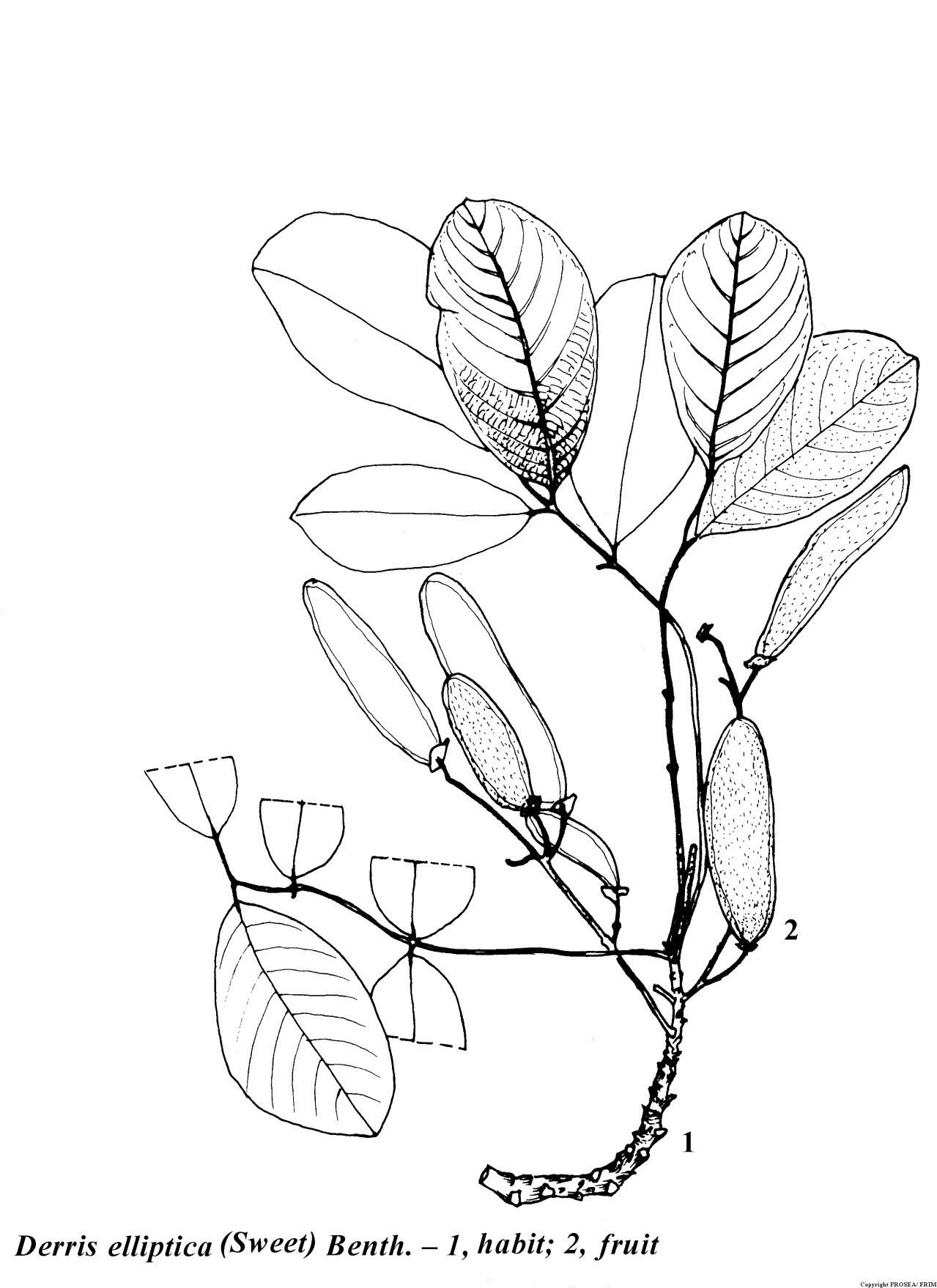Scientific Name
Derris elliptica (Wall.) Benth.
Synonyms
Cylista piscatoria Blanco, Deguelia elliptica (Benth.) Taub., Derris elliptica var. elliptica, Galactia termimaliflora Blanco, Galedupa elliptica Roxb., Millettia piscatoria Merr., Millettia splendidissima S.Vidal, Pongamia elliptica Wall., Pongamia volubilis Zoll. & Moritzi. [1]
Vernacular Name
| Malaysia | Akar tuba, tuba, tubah; tuba (Borneo), [2] tuba benar [3] |
| English | Derris, derris root, poison vine, tuba root, tuba root of Malaya [2] |
| China | Mao yu teng, du yu teng, nan ya yu teng [3] |
| India | Bakal bih, etam chali, hiru-alau, hilu-rikang, menu maari, mokoi sopa, ripiktom [2] |
| Indonesia | Akar tuba, oyod tungkul, tuba aka, tuwa leteng, [2] tuba [3] |
| Thailand | Hang lai daeng, ka-lam-pho, kalamphoh, khrua-lai-nam, pho-ta-ko-sa, uat-nam, [2] lain am [3] |
| Myanmar | Hon (Burma) [2][3] |
| Philippines | Tubli, tugling-pula [2], bauit, malasiag, tibalau, libanglan, tubling-pula Tagalog); lapak (Bikul); tuva (Ivatan); upei (Bontok) [3] |
| Cambodia | Ca bia, k’biehs [2] |
| Vietnam | D[aa]y m[aaj]t, [2] d[aa]y thu[oos]c c[as] [3] |
| Brunei | Tuba [2][3] |
| Japan | Derisu, haitoba, shirotoba, toba [2] |
| Fiji | Nduva, duva ni Vavalgai [3] |
| France | Touba [3] |
| Germany | Derria-wurzel, tuba-wurzel [3]. |
Geographical Distributions
Derris elliptica is distributed in Bangladesh, Burma (Myanmar), Indo-China, Thailand, the Nicobar Islands and Malesia (apparently not wild in Borneo, Sulawesi and the Moluccas). D. elliptica also cultivated in Southeast Asia, India, tropical Africa and America. [4]
Botanical Description
D. elliptica is a member of the Fabaceae family. [4] It is a liana that can grow up to 12m long. [5]
The shoot apex is often leafless for several meters. The leaves are pinnate, measures 15-30cm long, mostly with 7-15 leaflets. The leaflets are narrowly somewhat glabrous and glaucous beneath. The petiole is measure 3-7 mm long. [5]
The flowers are usually in stalked clusters of 3, combined into pseudorachemes measuring 15-25cm long, rusty pubescent. The calyx measures 6-8 mm long and shallowly toothed. The petals are pink in colour measure standard 13-17mm in diameter, with 2 auricles at base, softly ferruginous-hairy outside; wings and keel with interlocking longitudinal folds. [5]
The fruit elliptic to oblong-elliptic, measuring 3.5-7cm long, flat, leathery, narrowly winged. [5]
The seeds are 1-3, reniform, flat. [5]
Cultivation
D. elliptica is commonly found in forest edges, roadsides and along rivers, in Java up to 1500 m altitude. [5]
Chemical Constituent
D. elliptica roots has been reported to contain rotenone, derrid, anhydroderrid, derrin, tubotoxin, tubain, tephrosin, toxicarol, 4′,5′-dihydroxy-6a,12a-dehydrodegueline, 11,4’5′-trihydroxy-6a,12a-dehydrodeguelin, deguelin, and poly-hydroxyl octadecenoic acid, 12, 13, 15-trihydroxy-9-octadecenoic acid, 7′-hydroxy-6a, 12a-dehydrodeguelin, 6-hydroxy-6a, 12a-dehydrodeguelin, (6aR, 12aR, 4′R, 5′S)-4′, 5′-dihydro-4′, 5′-dihydroxytephrosin, 6′-hydroxy-6a, 12a-dehydrorotenone, (-)-rotoic acid, (-)-deguoic acid, and 12-deoxo-12α-acetoxyelliptone. [3]
Plant Part Used
Leaves and roots [3][5]
Traditional Use
D. elliptica is a potent fish poison used extensively in south, south-east Asia and the Pacific Islands a long time ago until it was banned by the various authorities. In Borneo, the roots extract forms part of the ingredient for making arrow poison. The powdered root is also used as insecticide. [3][4]
As an abortifacient, the roots are mixed with a little opium and inserted per vaginum at night. The Thai traditional practitioners make use of the roots as an emmenagogue. [3][4]
Preclinical Data
Pharmacology
Teratogenicity activity
Rotenone extracted from the roots of D. elliptica has been demonstrated teratogenicity effect in pregnant rats. Result obtained show that at a dose of 10mg/kg there was an increased in the number of non-pregnancy and resorption; at doses of 5mg/kg and 10mg/kg there were reduction in maternal body weight gain, fetal weight and skeletal ossification together in increase incidence of extra ribs; at dose of 2.5mg/kg no significant effects were found. [6]
Toxicity
No documentation.
Clinical Data
Clinical findings
No documentation.
Precautions
No documentation.
Side effects
No documentation.
Pregnancy/Breast Feeding
In view of the potential teratogenic effects of rotenone extracted from D. elliptica, it is advisable to exercise caution when using insecticide aerosols containing the substance in the presence of pregnant women. [6]
Age limitation
No documentation.
Adverse reaction
No documentation.
Interaction & Depletion
No documentation.
Contraindications
No documentation.
Poisonous Management
No documentation.
Line Drawing

References
- The Plant List. Ver1.1. Derris elliptica (Wall.) Benth. [homepage on the Internet]. c2013 [updated 2010 Jul 14, cited 2016 Aug 16]. Available from: http://www.theplantlist.org/tpl1.1/record/ild-33408.
- Quattrocchi U. CRC world dictionary of medicinal and poisonous plants: Common names, scientific names, eponyms, synonyms, and etymology. Volume II C-D. Boca Raton, Florida: CRC Press, 2012; p. 663.
- Philippine Medicinal Plants. Tubli. Derris elliptica Benth. [homepage on the Internet]. No date [updated 2013 Jul; cited 2016 Aug 16]. Available from: http://www.stuartxchange.com/Tubli.html.
- Hamid A. Derris elliptica (Wallich) Benth. In: de Padua LS, Bunyapraphatsara N, Lemmens RHMJ, editors. Plant resources of South-East Asia No. 12(1): Medicinal and poisonous plants 1. Leiden, The Netherlands: Backhuys Publisher, 1999; p. 240-241.
- The Agroforestree Database. Derris elliptica. [homepage on the Internet]. c2016 [cited 2016 Aug 16]. Available from: http://www.worldagroforestry.org/treedb2/speciesprofile.php?Spid=18064.
- Khera KS, Whalen C, Angers G. Teratogenicity study on pyrethrum and rotenone (natural origin) and runnel in pregnant rats. J Toxicol Environ Health. 1982;10(1):111-119.


